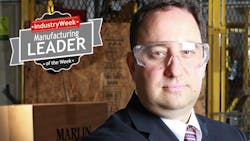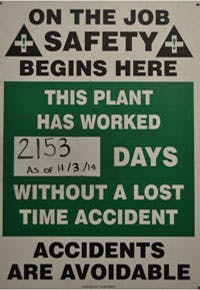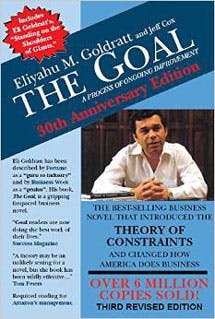Driving Innovation Throughout the Company at Marlin Steel
Drew Greenblatt, president & owner of Marlin Steel Products LLC, a manufacturer of custom wire and sheet metal forms, believes that driving innovation at all levels of the company is critical to the company's success.
Taking the following 10 "top actions," he says has spurred his company's growth for seven years in a row -- despite the recession.
"You really need a general" for every major project, Greenblatt declares. You need one person who can bring together teams to get things done and "who's ultimately responsible for the success or failure of an activity."
Too often, he says, most companies establish a committee to complete a project, such as onboarding equipment, upgrading software or improving a work process. However, he argues, that means that when something goes wrong--or right--it's hard to tell who is responsible.
A recent successful example of this best practice at Marlin was the onboarding of one of the world's latest, most advanced robotic welders, an IDEAL Welding System. (There are four in the world," Greenblatt notes. "Four in Germany, and we have the fifth one.")
To lead the project, Greenblatt chose one person, Production Manager Andrew Croniser, to own and run the project from beginning to end.
"That way, you have a single chain-of-command and a single focus to make sure that things run optimally," he explains. "That way Andy could ride herd on people who were not meeting their deadlines or were not doing something optimally."
The robotic welder arrived the day before a holiday weekend, and two weeks later, the company was shipping parts built with it.
Now, Greenblatt reports, the robot runs seven days a week, including three 12-hour days, Friday, Saturday and Sunday.
"We'd never run seven days a week, so to handle the machine -- "It's drumming up so much business," he adds -- Andy created and implemented that [weekend] shift, too."
"A tremendous, tremendous onboarding experience," Greenblatt concludes.
The second best practice builds on the first, as the "general" in charge of a project or activity is responsible for bringing together functional experts from throughout the company -- including production, engineering, maintenance, logistics, etc.
"With everybody, often multiple teams, looking through different parts of the prism, you have extraordinary insights and less chance that you'll overlook an elementary element," Greenblatt explains. The logistics person will, for example, see something that only a logistics person would.
The "general" also is in charge of the safety elements of a project, working with a safety team, itself a cross-functional group that meets monthly. "They advocate ideas that otherwise may be overlooked," Greenblatt notes.
For all onboarding projects, the project leader has the safety team helping to review all the ways that the new machine could harm one of their employees, and identify all the threats. "We get all the players in the room that will be operating the machine, the engineers that will design for it, the logistics people that will be moving material around it -- all to identify the scary elements of the new machine ... it's a very holistic approach."
"Having all the intelligent parties in the room," he concludes, "improves the chance that you're going to have a quick launch... and you'll have better quality the first day."
"Many times people tolerate a target that is easy to make," Greenblatt asserts. "By having an excellent team of "A" players, you can demand "big, hairy, audacious goals" that really move the needle -- that have a positive impact faster."
"If you don't challenge your team [to reach] for the farthest goal, you're going to get a complacent, underwhelming success," he says. However, if you set BHAGs, the team will almost always get farther than the average company will get.
"It's the stretch goals that really get people juiced up," Greenblatt adds. "It's the stretch goals that change companies to make sure that you can prosper & thrive in a challenging economic environment."
Greenblatt recounts the BHAG set for on-boarding the IDEAL robotic welder. While the manufacturer said to expect to be shipping parts in six to eight weeks, the Marlin Steel team set a BHAG of three weeks.
They beat the goal and were shipping parts two weeks after taking delivery of the welder.
"By not accepting the conventional way of implementation, we were able to completely exceed the conventional wisdom or practice for what's rational for the product," Greenblatt declares.
"We're always trying to improve every element of every cell by 1%, so by the end of the year, we'll be over twice as productive," Greenblatt says. As well, by striving to improve every day, every cell, "will make a little bit more money and, overall, the company will be more prosperous."
He continues: "The idea is to never be complacent. We're never satisfied. Even if we do something great... that's super. O.K., let's try to do it a little bit better tomorrow."
This continuous improvement philosophy derives from two books that influenced Greenblatt -- and which are required reading at the Marlin Steel.
"We're big disciples of lean manufacturing," Greenblatt asserts, noting the teams regularly hold Kaizen events to improve workflow.
He's particularly enamored of Eliyahu Goldratt, author of The Goal, declaring: "Because of his book, I took his practices and fused them into my company, and it saved my company," Greenblatt says.
Another influence is Shigeo Shingo, author of A Study of the Toyota Production System, which, among other practices, describes the development of SMED, or single-minute exchange of dies.
Greenblatt adds that he's made these books required reading for his management team. He says that, in addition to the knowledge, having the team read them provides the company with a common language to discuss continuous improvement practices.
"We actually give them a vacation day if they read it," he says.
In a high-performance environment, where you set BHAGs and expect continuous improvement in every element of every cell every day, "people stick their necks out," Greenblatt says. "More times than not, what happens is failure."
"If they are swinging for the fences, you've got to cut them some slack, you have to be accommodative," he asserts. "They have to know that you're not going to fire them if they have a couple strikeouts."
"If you do, the employees are going to take more risks, and you'll have a better chance of hitting the BHAG."
He recounts how an employee got a team together to figure out how to bend the four sides of a basket at the same time, rather than bending each side one at a time. The effort took 20 tries over six months to perfect. Now the approach is not only four times faster, it's safer.
"In some companies, they would get fired or a demotion," Greenblatt asserts. "We had faith in our team, and we stuck with it. And 20-plus iterations later, we're there."
He adds that the effort is a tribute to the "stick-to-itiveness" of the team: "Conceptually, the idea was a winner, but making it a reality was a challenge -- and a tribute to a wonderful team."
"A lot of companies are little islands," Greenblatt declared. "They don't communicate with outsiders or smart people who are near them. I highly recommend embracing local colleges/community colleges and universities."
Currently Marlin Steel is collaborating with John Hopkins University in robotics, developing some things that likely will be in the forefront of robotics for the next 10 to 20 years.
"Everybody in America has learning institutions near them that they should collaborate with," Greenblatt asserts, noting the symbiotic needs: colleges and universities need real-world projects in order to get grants and further their research, while companies need help solving their biggest challenges.
Besides, he adds, you can usually hire their graduates.
Twenty percent of Marlin Steel's employees are degreed mechanical engineers, and "they just come up with amazing ideas," Greenblatt says.
He continues: "I surround myself with crazy smart engineers; they think differently, they come up with elegant solutions, ideas and innovations."
The engineer-to-other-employee ratio is "off" in most average American companies, Greenblatt adds, concluding: "Everybody needs a heavy infusion of engineers, in general."
You want those engineers close to where the action is, co-located with marketing and sales near production people, where everything is being made -- at Marlin they are all within a football field of each other, according to Greenblatt.
He believes that if you have everyone close to each other and near where everything is being made, it makes it more likely that good ideas will happen. As well, if production runs into a problem, quality observes a defect or marketing has a question, they are right near each other to help each other.
Greenblatt acknowledges that Apple has been able to succeed without following this practice. "Apple is a wonderful company," he says. "However, if their factories were close to their engineers, I just think they could be even better and faster."
“Most companies have blue-collar workers who punch in at a certain time and punch out,” Greenblatt notes. “My employees are very dedicated and very engaged, because they have real ‘skin in the game.’ They’re like shop keepers, like entreprenuers.”
He credits a bonus system that pays out every two weeks, and that is based on the employee meeting very specific targets, “so the employees have a real ability to impact their personal success,” Greenblatt explains.
Since they have 26 pay periods to get the bonus, it can have an enormous impact on the employee’s family budget. “It’s very simple,” Greenblatt adds. “If you hit your numbers, you get a big check; if you don’t hit your numbers, you don’t get a big check.”
He continues: “The average [work] cell hits 14 times a year, some get it as many as 22 times a year, and some hit it as few as eight. The target is not too hard that you can’t do it, and it’s not too easy that you get it every pay period, so people are very engaged.”
As a result, they’re thinking after hours, he adds. “I get emails after hours, what if we [did this or that]? You’d never see that from a conventional blue collar employee.”
He concludes, “We have entrepreneurs. We don’t have blue collar workers.”
“When I first bought the company [in 1968], the newest piece of equipment was from the 1950s,” Greenblatt says, noting that that's not unusual. "A lot of these companies have old, outdated, stale equipment and stale software that's not cutting edge."
How can you expect your employees to hit a BHAG or come up with a great new, state-of-the-art idea in that situation, if you're using vintage equipment?" he asks.
However, if you replace a press brake with a tolerance of +-1/16th of an inch with one with a 0.1 micron tolerance, "You can look them straight in the eye and ask for the BHAG," Greenblatt asserts. "I can demand a tighter tolerance, because I'm giving you the equipment that can do that."
"You have to give them those steroids, you have to give that technology so that they can perform better," Greenblatt asserts.
"We've done that over the past couple, we've spent over $4 million dollars," he adds. "And it's had an impact."
About the Author
Patricia Panchak
Patricia Panchak, Former Editor-in-Chief
Focus: Competitiveness & Public Policy
Call: 216-931-9252
Follow on Twitter: @PPanchakIW
In her commentary and reporting for IndustryWeek, Editor-in-Chief Patricia Panchak covers world-class manufacturing industry strategies, best practices and public policy issues that affect manufacturers’ competitiveness. She delivers news and analysis—and reports the trends--in tax, trade and labor policy; federal, state and local government agencies and programs; and judicial, executive and legislative actions. As well, she shares case studies about how manufacturing executives can capitalize on the latest best practices to cut costs, boost productivity and increase profits.
As editor, she directs the strategic development of all IW editorial products, including the magazine, IndustryWeek.com, research and information products, and executive conferences.
An award-winning editor, Panchak received the 2004 Jesse H. Neal Business Journalism Award for Signed Commentary and helped her staff earn the 2004 Neal Award for Subject-Related Series. She also has earned the American Business Media’s Midwest Award for Editorial Courage and Integrity.
Patricia holds bachelor’s degrees in Journalism and English from Bowling Green State University and a master’s degree in Journalism from Ohio University’s E.W. Scripps School of Journalism. She lives in Cleveland Hts., Ohio, with her family.



